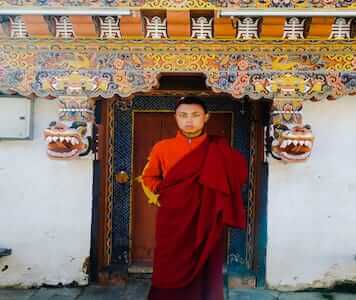 Having always been politically independent, a rich and distinctive culture developed in the country over the ages. Perhaps the most important single factor in the moulding of Bhutanese character and thought has been the teaching of Lord Buddha, whose eternal truths were first brought into the country from Tibet over the high, snow-bound mountain Passes by the great Indian saint, Guru Padmasambhava.
Having always been politically independent, a rich and distinctive culture developed in the country over the ages. Perhaps the most important single factor in the moulding of Bhutanese character and thought has been the teaching of Lord Buddha, whose eternal truths were first brought into the country from Tibet over the high, snow-bound mountain Passes by the great Indian saint, Guru Padmasambhava.
In the Buddhist perspective, culture, tradition and beliefs and the environment are dynamic phenomena that are interwoven tightly in the web of life. As a Buddhist philosopher say, 'Culture lies not in objects or monuments but in the mind and compassion towards all sentient beings'.
Bhutan's unique cultural and traditional ethos, highly valued in themselves by all the population, are the essential embodiments of the nation's identity. For a small country located between the two most populated countries of the world, India and China, the preservation and promotion of its distinct cultural identity are seen as an important means for its survival as an independent and sovereign Kingdom. It was this identity that has protected and sustained Bhutan and also provided the foundation for its major policies.
Architecture
In terms of quality and originality, Bhutanese architecture is without doubt one of the best expression of the country's unique character. Almost completely isolated for several centuries owing to its complex geography, Bhutan has indeed seen very few changes in its architectural system since the earliest times. The main roots of its architecture go to Tibet, which was itself in relation to China and faraway Persia, thanks to traders travelling on the silk route. Drawing inspiration from older forms and ideas, the architects of Bhutan developed a style that is peculiar to their own country. Displaying a great sense of innovation, they made each dzong, temple and monastery a unique creation, different from all others but at the same time maintaining a perfect unity of architectural style throughout the country. Each of these buildings was designed and built to harmonize with the environment and fulfil certain specific functions and many of them are true masterpieces.
Dzongs
The great fortresses known as 'Dzongs' are among the most striking example of Bhutanese architecture. Rising proudly at strategic places, at the entrance to the valley, at the summit of a hill or at the confluence of two rivers, Dzongs are built on a grand scale without the help of any drawings and held without a single nail and are outstanding examples of the best in Bhutanese architecture. Reflecting a certain view of religion, society and spatial organization, the Dzongs symbolize the history and long independence of Bhutan.
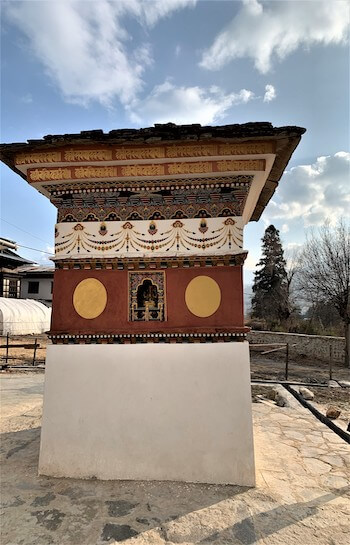 Chortens
Chortens
The commonest structures in Bhutan are not the great fortresses but 'Chortens', which are also known as 'Stupas'. There are numerous Chortens all over the country, ranging in size from very small to large. Witness to the profound faith of the Bhutanese, they can be found at crossroads, near a Dzong or a Monastery and on high mountain passes and all of them have an indefinable presence, radiating serenity and peace.
Lhakhangs
Lhakhangs (temples) are fairly small buildings of simple design, seem to have been the first forms of religious architecture. Built in simple design they are likely to comprise one storey around a small enclosed courtyard and differ from ordinary houses by red band painted on the upper part of their walls and an ornament of gilded copper on the roof. Inside, the walls are completely covered with religious paintings.
Goembas
Bhutanese Goembas (monasteries) can be divided into two types: 'Cluster type' which consists of a core formed by one or two temples with various dwelling structures grouped around such as Dzongdrakha in Paro valley, Phajoding in Thimphu valley and Tharpaling in the Bumthang valley. The second category 'Dzong type' is built like a fortress with the central tower enclosing the temple and surrounded by exterior walls against which are built monks cells and service rooms. The most impressive example of Dzong type goembas is the monastery of Gangtey and Tango in upper Thimphu valley.
Village houses
The villages of Bhutan often take the form of small hamlets of between 5 to 15 houses, arranged in such a way as to mitigate the harsher effects of the climate. They are built close together to provide mutual protection against the wind and the cold. Typical Bhutanese houses are found at altitudes of 1,000 to 3,000 meters. The general pattern is almost the same throughout the country.
Religion
Bhutan is the only country in the world to have adopted Mahayana Buddhism in its Tantric form as its official religion. The Buddhist faith has played and continues to play a fundamental role in the cultural, ethical and sociological development of the country and its people. Monks are held in great respect and play an active part in community life.
The influence of Tantric Buddhism since the mid 7th century has irrevocably shaped Kingdom's history and destiny and has had an indelible and enlightening impact on the Bhutanese way of life. It affects almost everything, from arts and crafts to the system of government, from folk dances to architectural style. To this day also, the importance and relevance of Buddhism have not waned and Buddhist values and traditions still permeate every aspect of the Bhutanese culture and ethos.
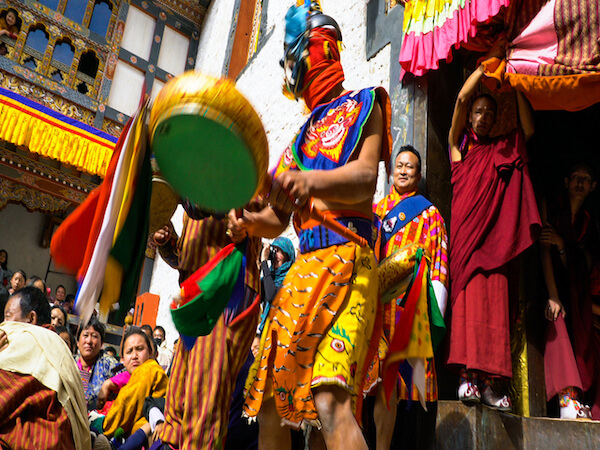 Festivals
Festivals
At different times of the year, the annual festivals known as 'Tshechus' take place in different locations. These Tshechus are festivals extolling the great deeds of Guru Padmasambhava also known as Guru Rinpoche. Festivals are celebrated for several days between three to five and are the occasion for dances that are purely defined in religious content. Dancers in brilliant silk costumes re-enact legendary events, accompanied by blaring horns, booming drums and clashing cymbals as they whirl and leap against a background of sky and mountains. Certain festivals end with the unveiling and worship of huge religious appliques or 'Thongdroel' (or thangkha) – an embroidered painting. Thongdroels are especially impressive examples of Buddhist art and are considered so sacred that simply seeing a Thongdroel is said to cleanse the viewer of all sin.
For the Bhutanese people, religious festivals offer an opportunity to become immersed in the meaning of their religion and gain much merit. They are also the occasion for seeing people and for being seen, for social exchanges and for flaunting success. People bring out their finest clothes and their most beautiful jewellery. An atmosphere of convivial, slightly ribald with humour prevails.
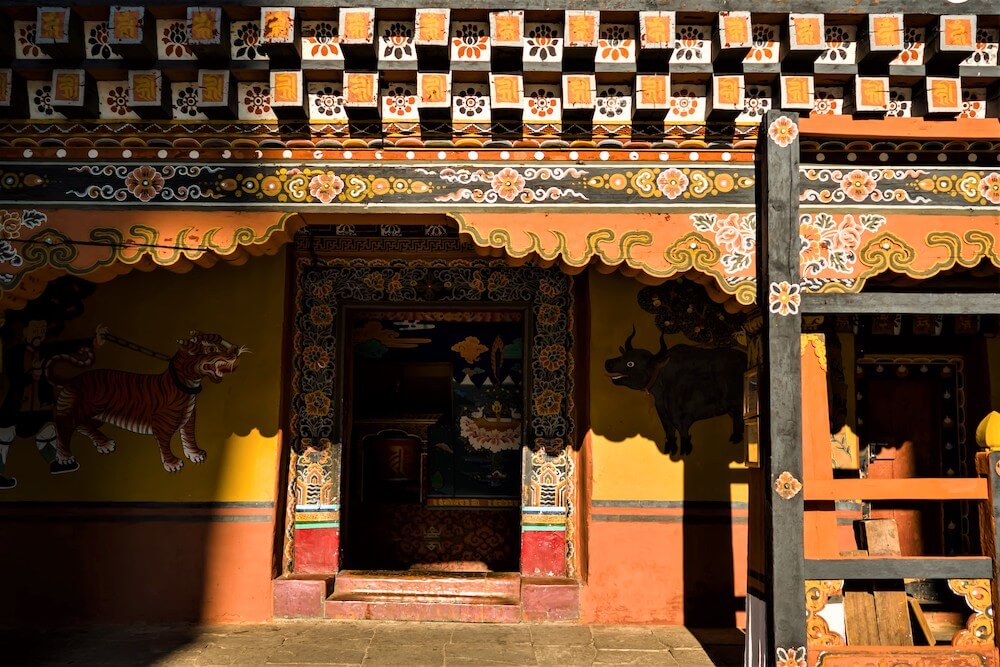 Arts & Crafts
Arts & Crafts
Bhutanese traditional arts and crafts draw upon a long tradition deeply imbued with spiritual significance. This traditional arts and crafts continue to possess their religious and spiritual significance and retain relevance in the minds and lives of the people.
All Bhutanese art, dance, drama and music have their roots in the Buddhist religion. And this Buddhist art has a much different purpose from other contemporary art, being more subjective, symbolic and impersonal. Unlike many other countries, arts, ceremonies and festivals of Bhutan are not remnants of a bygone age but they are still practised and performed because they continue to have religious and spiritual significance and they are the manifestation of a living culture.
Inspired by their close relationship with nature and their Gods, and by the extraordinary scenery of their country, Bhutanese craftsmen have preserved the ancient skills of their ancestors through work in bronze, iron, silver, clay, and wood.
The Bhutanese consider commissioning paintings and statues as pious acts, which gain merit for the patron. Other than its spectacular architecture, the most visible manifestation of Bhutanese art is painting which is defined in three forms; thangkhas, wall paintings and statues.
The country's primary dance form is classical lama dancing. All of the dances are religious and symbolize the destruction of evil spirits. The most important festival dances, celebrate the faith, legends, myths and history of the Kingdom and are important religious and social gatherings.
Among Bhutan's many hidden treasures is a magical mosaic of rich, vibrant hues and patterns, in myriad weaves. The weaves that have today become vivid symbols of the Dragon Kingdom.
Archery – the National Sport
Archery is the national sport of Bhutan and every village has its own archery range. High spirited competitions, usually accompanied by a banquet, are a part of all festive occasions. Using bamboo bows (although modern compound bows are now common in cities) team of archers shoot at targets only 30 centimetres in diameter from a distance of 120 meters. Each team has a noisy crowd of supporters who, as well as encouraging their own side, try to put off the opposition. Archery competitions are among the most picturesque and colourful events in the country and are an integral part of all festivities. Inter-village rivalry is common throughout the Kingdom and this rivalry is no more fiercely expressed than during annual archery tournaments. They are generally held at Losar (Bhutanese New Year) but smaller competitions are held throughout the year.
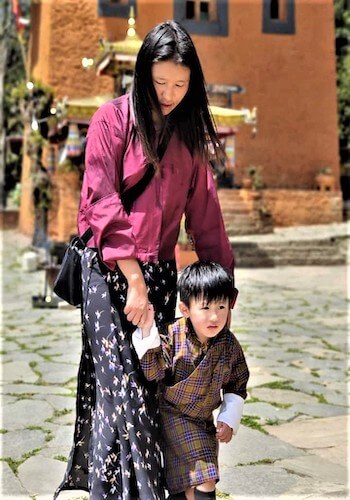 Dress
Dress
The National dress of Bhutan is one of the most distinctive and visible aspects of Dragon Kingdom's unique character. Men wear 'Gho', a long robe similar to Tibetan Chhuba while women wear, ankle-length robe called 'Kira'. The Bhutanese textile is made from fine, hand-woven fabric, with colourful distinctive patterns.
Formal occasions, require men to wear a scarf called 'Kabney' that also indicates a person's rank. Wearing Kabney is an important part of Bhutanese etiquette. In the same manner, women wear 'Rachu' over their left shoulder on all formal occasions.
The Way of Life
Still a majority of the population of Bhutan continues to live as it has for centuries – in small isolated farms and hamlets, surrounded by terraced fields of rice, maize and buckwheat. Higher up, many people live in tents woven from yak-hair, spending at least part of the year on the alpine pastures among their grazing livestock.
One trait which is common to all Bhutanese is hospitality. Custom dictates that simple hospitality is extended to any and all guests, even to perfect strangers.
In Bhutan, everyone seems to wear a smile. Perhaps this is due to their deep-rooted Buddhist faith or maybe their sense of contentment is due to their self-sufficient lifestyle. Whatever the reason, the Bhutanese project apparent inner happiness that travellers will remember long after their visit.